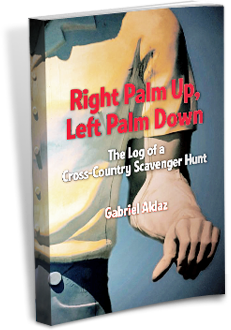Resources
This is an incomplete list of Muffler Man resources. I welcome corrections and additions to the list!
Websites
Roadside America
Jack Barth, Doug Kirby, Ken Smith, and Mike Wilkins are road-trip pioneers whose 1986 book Roadside America brought attention to numerous obscure and offbeat tourist attractions. During their journeys, they naturally encountered fiberglass statues standing with their right palm up and left palm down. By coincidence, the first ones they saw held mufflers; hence was born the misnomer “Muffler Man.”
The Roadside America website launched in 1996 and catalogs nearly every unusual museum, giant ball of twine, and donut-shaped eatery across the United States. Unfortunately, in 2023 their origin story still inaccurately states, “These colossi were originally created in the 1960s by a California fiberglass company for gas station chains in sizes ranging from 14 to 25 feet. M-Men once beckoned noisy and exhaust-weary vehicles to replace their mufflers. The statues’ hands were molded to hold mufflers or tires.” We know that the first Paul Bunyan was created for the Lumberjack Cafe in Flagstaff, Arizona, and the hands were molded to hold an axe.
The Roadside America Muffler Man Map is an excellent, well-maintained map showing the location of all known Muffler Men, with different icons denoting the type: Bunyans, Cowbowys, Indians, Mortimer Snerds (called Happy Halfwits by Roadside America), and more.
American Giants
Joel Baker, the founder of American Giants, got in touch with me in 2011 wanting to know details beyond what was covered in RPULPD. I knew then that Joel was serious about Muffler Men! We were both considered a little crazy at the time. While I took a pause to pursue other interests, Joel has gone on to become an authority on the subject. Joel made some great videos for his American Giants YouTube channel, and in 2015, he and his team at American Giants started restoring Muffler Men and other fiberglass giants. American Giants now helps businesses find, purchase, refurbish, transport, and set up Muffler Men, which have become top roadside attractions.
Future Studio
Amy Inouye is a freelance book designer who has worked on over 250 book projects (including RPULPD) and has a passion for vernacular architecture. When she moved to Los Angeles in the mid-1980s, Amy encountered a restaurant on Broadway called Chicken Boy, complete with a rooftop statue with a chicken head that held a bucket of chicken. When the restaurant changed hands, Amy rescued Chicken Boy from certain destruction. She stored him for decades before relocating him to her Future Studio headquarters along Route 66. Amy, known as “the Mother of Chicken Boy,” continues to care for Mr. Boy, who continues to receive daily visitors.
Roadside Vacationx
Stefanie and Mario Schweda are two Germans who have become addicted to the beautiful nature and oversized roadside attractions of the United States. As time permits, they travel across the ocean once or twice per year on two-to-five-week road trips. They catalog their roadside findings on their website, Roadside Vacationx, and have sections devoted to Muffler Men and Uniroyal Gals, among many others.
Books
Barth, Jack, Doug Kirby, Ken Smith, and Mike Wilkins. Roadside America. New York: Fireside, 1986.
Butko, Brian and Sarah Butko. Roadside Giants. Mechanicsburg, PA: Stackpole, 2005.
Freeth, Nick. Route 66: 2297 Miles from Chicago to LA. Osceola, WI: Motorbooks International, 2001.
Heimann, Jim. California Crazy and Beyond: Roadside Vernacular Architecture. San Francisco: Chronicle, 2001.
Heimann, Jim. California Crazy. American Pop Architecture: Roadside Vernacular Architecture. Cologne, Germany: Taschen, 2020.
Kirby, Doug, Ken Smith, and Mike Wilkins. New Roadside America: The Modern Traveler’s Guide to the Wild and Wonderful World of America’s Tourist. New York: Fireside, 1992.
Mangum, Richard and Sherry. Route 66 Across Arizona: A Comprehensive Two-Way Guide for Touring Route 66. Flagstaff, Arizona: Hexagon, 2001.
Margolies, John. Roadside America: Architectural Relics from a Vanishing Past. Los Angeles: Taschen America, 2010.
This 1985 photo at the Jolly Roger Amusement Park appears on page 68 and is one of thousands of color slides in the John Margolies Roadside America Photograph Archive.
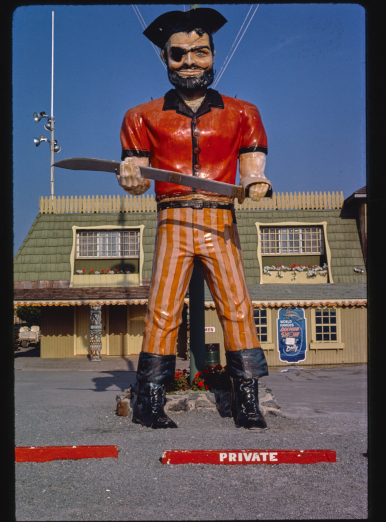
Lewis, Lucinda. Roadside America: 365 Days. New York: H.N. Abrams, 2003.
Patton, Phil. Open Road: A Celebration of the American Highway. New York: Simon and Schuster, 1986.
Snyder, Tom. Route 66: Traveler’s Guide and Roadside Companion. New York: St. Martin’s Griffin, 2000.
Venturi, Robert, Denise Scott Brown, and Steven Izenour. Learning from Las Vegas: The Forgotten Symbolism of Architectural Form. Cambridge: MIT Press, 1972.
Wade, Bob, with Keith and Kent Zimmerman. Daddy-O: Iguana Heads and Texas Tales. New York: St. Martin’s Press, 1995.
Wallis, Michael. Route 66: The Mother Road. New York: St. Martin’s Press, 1990.
Wallis, Michael. Route 66: The Mother Road, 75th Anniversary Edition. New York: St. Martin’s Press, 2001.
Witzel, Michael Karl. Route 66 Remembered. Osceola, WI: Motorbooks International, 1996.
Magazine Articles
Many articles have been printed about the Muffler Men, but one of the most important is the one that appeared in Smithsonian magazine.
Ross, John F. “Wanted: Big Men.” Smithsonian Oct. 2000: 118.
Additionally, several AAA magazines featured Muffler Men on the occasion of their 50th birthday.
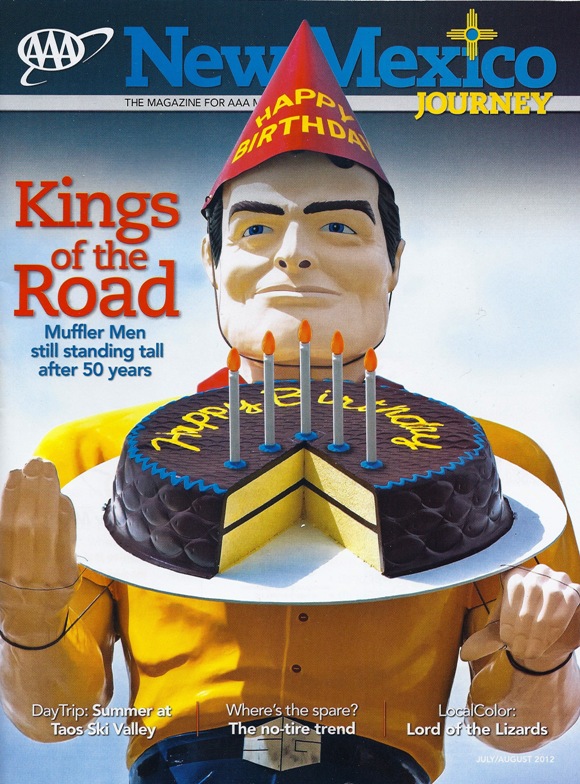
AAA Texas Journey, January/February 2013.
AAA New Mexico Journey, July/August 2012.
AAA Highroads (Arizona), May/June 2012.
AAA Westways (Southern California), January/February 2012.
Movies
Easy Rider (1969)
At the start of the film, Wyatt and Billy ride past Louie II in front of the Lumberjack Cafe in Flagstaff, Arizona. Louie, by the front door, did not make it into the frame.
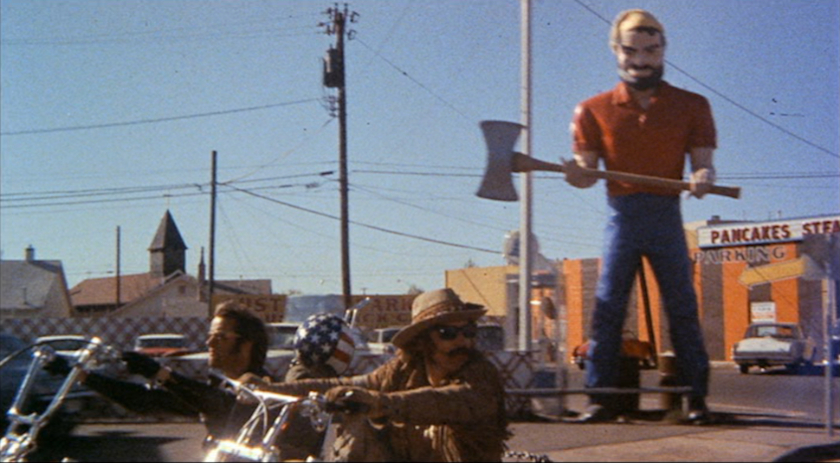
Wayne’s World (1992)
In the famous scene where Wayne, Garth, and friends sing “Bohemian Rhapsody,” they drive past the Eye Care Indian on the northwest corner of Pulaski Road and 63rd Street in Chicago.
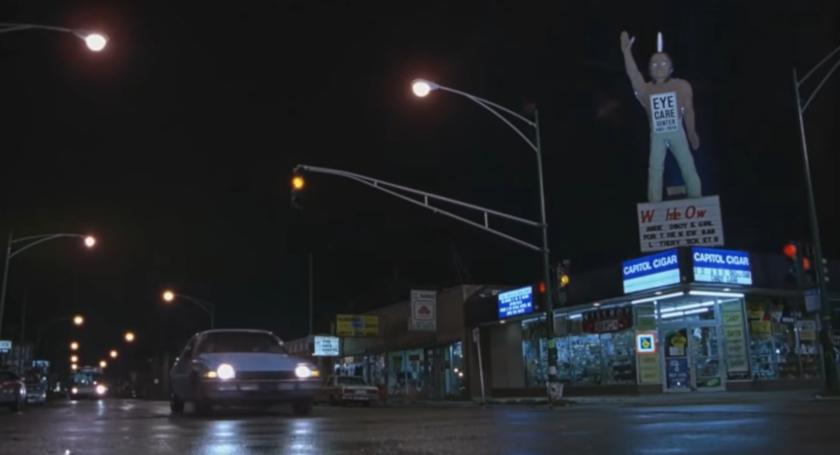
Nebraska (2013)
Aging, grumpy Woody Grant decides to start walking from Montana to Nebraska to claim as sweepstakes prize. As he sets off down the road in Billings, the L.P. Anderson Tire Muffler Man is clearly seen in the background.
Semi-Pro (2008)
A Mortimer Snerd stands in front of the Flint Coliseum, home of the Flint Tropics basketball team.
Q: The Winged Serpent (1982)
The winged serpent snatches a sunbather from a nearby roof. As it flies over none other than Chicken Boy, blood splatters.
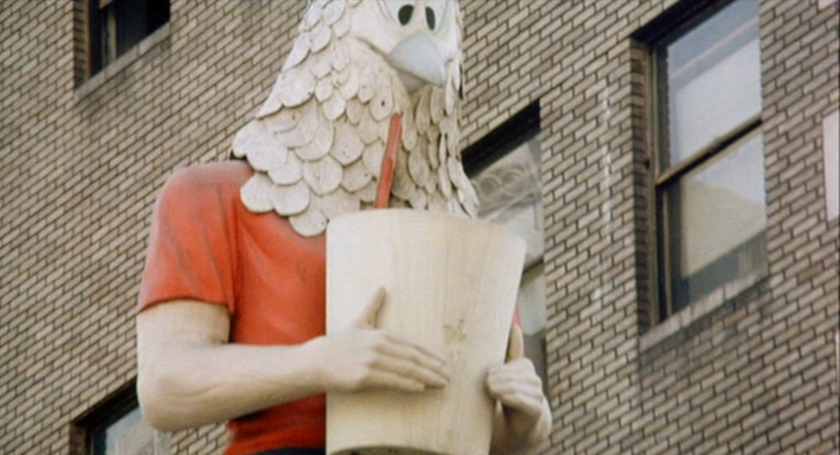
Battlefield Earth (2000)
In this truly forgettable movie starring John Travolta, a lame, computer-generated Muffler Man holds a giant combination wrench.
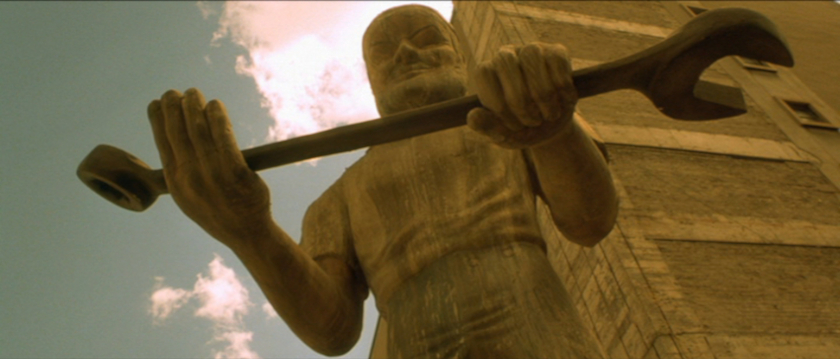
Television Series
The Sopranos (1999-2007)
The opening credits show the Carpet Giant in front of Wilson’s Carpet in Jersey City, New Jersey.
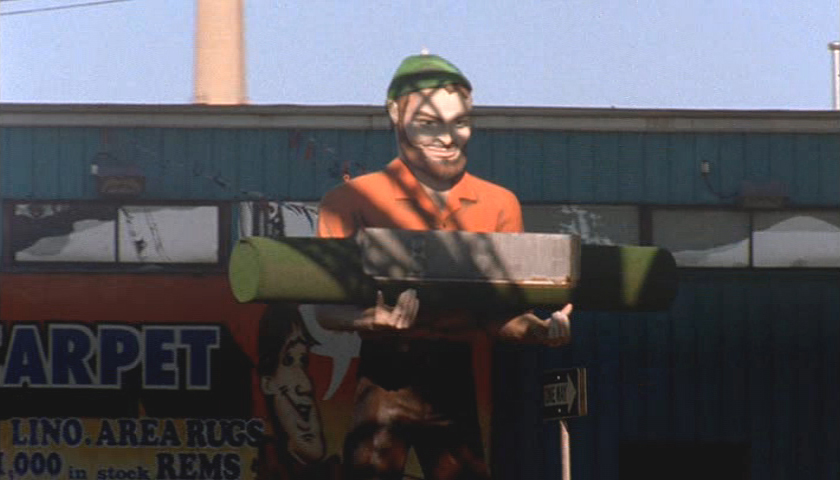
Parks and Recreation (2009-2015)
The opening credits briefly flash an Indian Chief in Montpelier, Indiana.
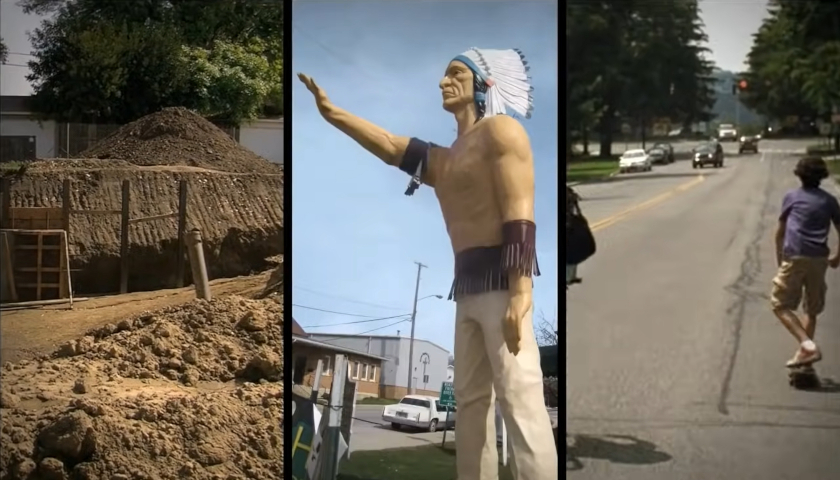
Ozark (2017-2022)
“Blue Cat” (Season 1, Episode 2). Jonah Byrde neglects his duty to safeguard a motel room full of cash, instead discovering the Indian Chief in Lake of the Ozarks, Missouri. This statue was restored by American Giants.
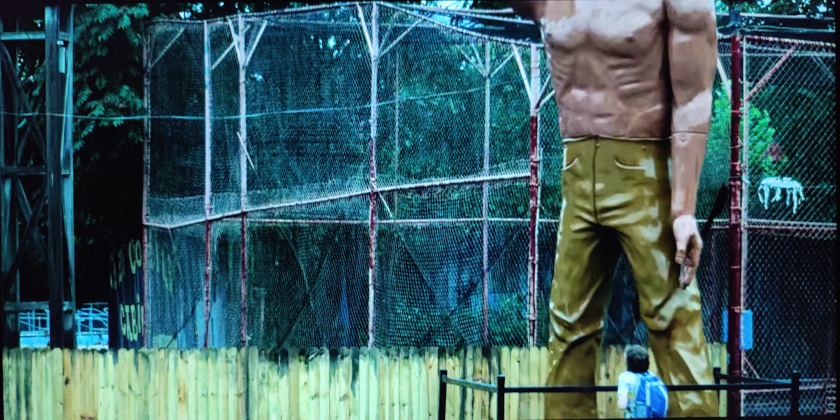
Florida Man (2023)
A Paul Bunyan was used in a scene where a lumberyard falls into a sinkhole. The head and axe are visible above the water.
The A-Team (1983-1987)
“Timber!” (Season 3, Episode 5). A Bunyan guards the Groverville gas station, where a corrupt gang bullies local lumberjacks to join a union. That is, until the A-Team steps in.
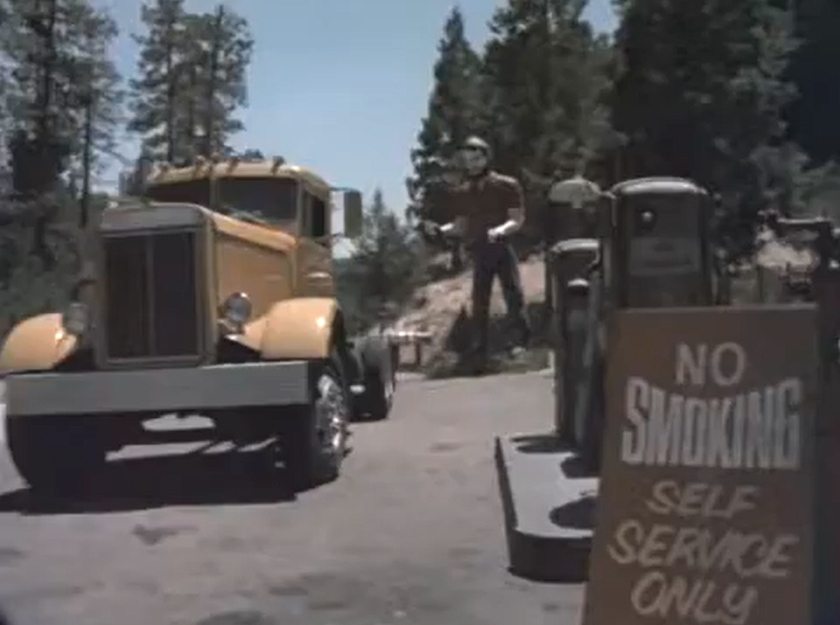
Comic Strips
Zippy the Pinhead
The main character, Zippy, is fascinated by roadside icons and giant fiberglass beings, including the Muffler Men.
